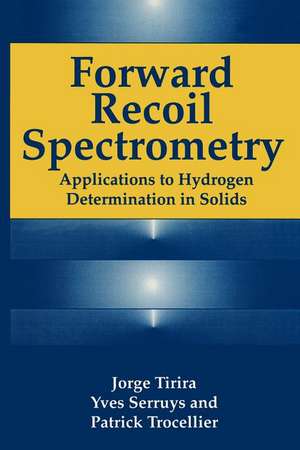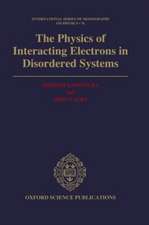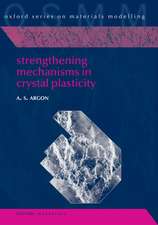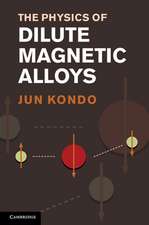Forward Recoil Spectrometry: Applications to Hydrogen Determination in Solids
Autor Y. Serruys, J. Tirira, P. Trocellieren Limba Engleză Paperback – 2 oct 2011
Preț: 396.78 lei
Nou
Puncte Express: 595
Preț estimativ în valută:
75.92€ • 78.33$ • 63.36£
75.92€ • 78.33$ • 63.36£
Carte tipărită la comandă
Livrare economică 26 martie-09 aprilie
Preluare comenzi: 021 569.72.76
Specificații
ISBN-13: 9781461380122
ISBN-10: 146138012X
Pagini: 468
Ilustrații: 434 p.
Dimensiuni: 152 x 229 x 25 mm
Greutate: 0.62 kg
Ediția:Softcover reprint of the original 1st ed. 1996
Editura: Springer Us
Colecția Springer
Locul publicării:New York, NY, United States
ISBN-10: 146138012X
Pagini: 468
Ilustrații: 434 p.
Dimensiuni: 152 x 229 x 25 mm
Greutate: 0.62 kg
Ediția:Softcover reprint of the original 1st ed. 1996
Editura: Springer Us
Colecția Springer
Locul publicării:New York, NY, United States
Public țintă
ResearchCuprins
1. Introduction.- 1.1. General Description.- 1.2. Objectives.- 1.3. Topics.- 1.4. Historical Background.- 1.5. Extension of the ERDA Method in IBA Laboratories Worldwide.- 1.6. Conclusion.- References.- 2. Basic Physical Processes of Elastic Spectrometry.- 2.1. Introduction.- 2.2. Kinematics of Elastic Collision.- 2.3. Geometric Considerations.- 2.4. Energy Loss.- 2.5. Straggling.- 2.6. Conclusion.- References.- 3. Elastic Scattering: Cross-Section and Multiple Scattering.- 3.1. Introduction.- 3.2. Elastic Cross Section.- 3.3. Multiple Scattering.- References.- 4. Elastic Spectrometry: Fundamental and Practical Aspects.- 4.1. Introduction.- 4.2. Fundamentals of Recoil Spectrometry.- 4.3. Practical Spectrometry of Real Targets.- References.- 5. Conventional Recoil Spectrometry.- 5.1. Introduction.- 5.2. Mass—Depth and Recoil-Scattered Ion Ambiguities.- 5.3. Glancing Geometry.- 5.4. Transmission Geometry.- 5.5. Sensitivity.- 5.6. Mass Resolution.- References.- 6. Time of Flight ERDA.- 6.1. Introduction.- 6.2. General Considerations.- 6.3. Time of Flight Detector.- 6.4. Electrostatic Mirror Detector.- 6.5. Efficiency and Resolution.- 6.6. Data Analysis Procedure.- 6.7. Conclusion.- References.- 7. Depth Profiling by Means of the ERDA ExB Technique.- 7.1. Introduction.- 7.2. Physics and Properties of the ExB Filter.- 7.3. Practical Considerations.- 7.4. Adjustments for a 350-keV Helium Beam.- 7.5. Depth Profiling with a High-Energy (MeV) Beam.- 7.6. Modified ExB Filter for Heavier Elements.- 7.7. Conclusion.- References.- 8. Recoil Spectrometry with a ?E-E Telescope.- 8.1. Introduction.- 8.2. Experimental Considerations.- 8.3. Performances.- 8.4. Examples.- 8.5. Conclusion.- References.- 9. Coincidence Techniques.- 9.1. Introduction.- 9.2. Transmission Geometry andCoincidence Techniques.- 9.3. Single-Element Analysis with CERDA.- 9.4. Multiple-Element Analysis with CERDA.- 9.5. Scattering Recoil Coincidence Spectroscopy.- 9.6. Elastic Recoil Coincidence Spectroscopy.- 9.7. Position-Sensitive Detectors for Coincidence ERDA Techniques.- 9.8. Conclusion.- References.- 10. Instrumental Equipment.- 10.1. Introduction.- 10.2. Accelerator and Related Equipment.- 10.3. Beam Line.- 10.4. Analysis Chamber.- 10.5. Detection Devices.- 10.6. Conclusion.- References.- 11. Numerical Methods for Recoil Spectra Simulation and Data Processing.- 11.1. Introduction.- 11.2. Simulation Process: Basic Method.- 11.3. Alternative Simulation Process: Retrograde Method.- 11.4. Profile Extraction from Experimental Spectra.- 11.5. Algorithms and Programs.- 11.6. Adaptation to Other ERDA Variants.- 11.7. Conclusion.- References.- 12. Applications of Elastic Recoil Spectrometry to Hydrogen Determination in Solids.- 12.1. Introduction.- 12.2. Applications in Polymer Sciences.- 12.3. Applications to Semiconductor Materials.- 12.4. Applications to Thin Films.- 12.5. Study of Interface Reactions.- 12.6. Other Application Fields.- 12.7. Study of Hydrogen Behavior under Irradiation.- 12.8. Conclusion.- References.- 13. Elastic Recoil Spectrometry Using High-Energy Ions for Hydrogen and Light Element Profiling.- 13.1. Introduction.- 13.2. General Considerations.- 13.3. Experimental Arrangement for HI-ERDA.- 13.4. Detection Capabilities.- 13.5. Application Examples.- 13.6. Conclusion.- References.- 14. Ion-Beam Damaging Effects.- 14.1. Introduction.- 14.2. Basic Considerations on Ion-Beam Damaging.- 14.3. Elemental Losses.- 14.4. Reduction of Radiation Damage.- 14.5. Choice, Preparation, and Stability of Standard Samples.- 14.6. Conclusion.- References.- 15. HydrogenDetermination by Nuclear Resonance.- 15.1. Introduction.- 15.2. General Considerations.- 15.3. Hydrogen Profiling by Nuclear Resonance.- 15.4. Comparison with Elastic Recoil Spectrometry.- 15.5. Conclusion.- References.- General Conclusion.- Acknowledgments.- Appendix A. Basic Data References.- Appendix B. Calculation of the Detection Solid Angle.- Appendix C. Specific Units, Physical Constants, and Conversion Factors.- Appendix D. Recent References.- Appendix E. Acronyms.















